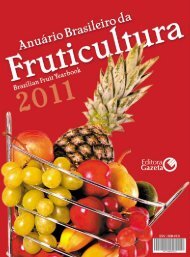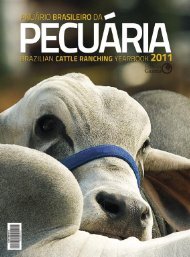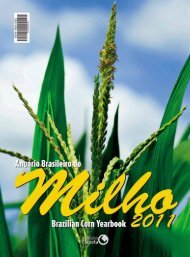tradicionalmenteinovador - Brazil Buyers & Sellers
tradicionalmenteinovador - Brazil Buyers & Sellers
tradicionalmenteinovador - Brazil Buyers & Sellers
You also want an ePaper? Increase the reach of your titles
YUMPU automatically turns print PDFs into web optimized ePapers that Google loves.
ing States are the leading producers: Pará, with 4.6 million tons,<br />
Paraná (4.4 million tons) and Bahia (3.6 million tons). The three<br />
states are projected to increase their planted areas, an item at<br />
which the first of them leads with 294 thousand hectares. Pará<br />
and Bahia are expected to harvest more per hectare, a topic<br />
where Paraná stands out. In 2011, nevertheless, the state experiences<br />
a slight reduction, from 23 to 22 tons per hectare, but, at<br />
the same time, the state is announcing an area expansion from<br />
172 thousand to 202 thousand hectares.<br />
The better prices are credited with the area recovery in 2010,<br />
a year when production volumes were smaller, a fact that had<br />
reflections on the production of starch and flour. It is reckoned<br />
that, by virtue of the shortage of raw material, the production<br />
of starch was down 2% to 5% from 2009, when it had peaked<br />
to 583.85 thousand tons. Paraná is a major producer, and accounts<br />
for 71% of the total, and the sector of paper and cardboard<br />
is the biggest consumer (23,8%), according to numbers<br />
from the <strong>Brazil</strong>ian Association<br />
of Cassava and<br />
Starch<br />
Producers<br />
(Abam) and from the<br />
Center for Advanced Studies<br />
on Applied Economics at Luiz de<br />
Queiroz College of Agriculture, linked with<br />
the University of São Paulo (Cepea/Esalq/USP).<br />
Data from the <strong>Brazil</strong>ian Secretariat of Foreign Trade<br />
(Secex), in turn, reveal smaller fresh starch exports, which remained<br />
below 6 thousand tons, while imports of the product<br />
soared to 11 thousand tons. On the other hand, good results<br />
were achieved with foreign sales of modified starch, which<br />
achieved the highest numbers in the decade: 36.7 thousand<br />
tons, bringing in US$ 39.4 million.<br />
Regarding the remuneration and performance of the sector,<br />
direct interference and competition comes from corn starch,<br />
which registered high prices over the period. Researcher Carlos<br />
Estêvão Cardoso, of Embrapa Cassava and Fruit Farming,<br />
in Cruz das Almas (BA), comments that the starch sector has<br />
the capacity to double its production volumes, which does not<br />
occur particularly because of the competition from the same<br />
product made of corn. In Bahia, where he is a member of the<br />
Cassava Productive Chamber of the State, Cardoso celebrates<br />
the decision to join this industrial segment, with the recent inauguration<br />
of a starch factory in Recôncavo Sul (municipality<br />
of Laje), with the capacity to process 200 tons a day, and another<br />
factory now being constructed in the Southwest (Vitória<br />
da Conquista).<br />
>> STRATEGY Embrapa researcher Carlos Estêvão Cardoso<br />
is also a member of the Cassava Sectorial Chamber and<br />
Byproducts at the Ministry of Agriculture, Livestock and Food<br />
Supply (Mapa), where he insists on two initiatives of interest<br />
to the area. Initially, the so-called Strategic Agenda, which involves<br />
several segments and could improve the availability of<br />
precise and fast information for decision taking, as well as research<br />
and development opportunities of the chain. Another<br />
debate taken as relevant for the sector, particularly in Paraná,<br />
is geared towards the chance of getting a register of phytosanitary<br />
products for roots and tubers and also for cassava. In<br />
general, cassava is valued as energy or food. In the food area,<br />
Cardoso understands, it could join the sector of fine and distinguished<br />
gastronomy, including cheese bread, tapioca and other<br />
confections. He stresses that, in general, starch made from<br />
root can be consumed by celiac sufferers, without any problem.<br />
As for the energetic purpose, he observes that the debates are<br />
just starting, but there is potential, in particular, for fine alcohol.<br />
Among the efforts towards adding more value to the product,<br />
Embrapa created the Cassava Day, which is celebrated<br />
on 18th April. On this special event, held in Cruz das Almas in<br />
2011, cassava was introduced as <strong>Brazil</strong>’s Root Symbol – the<br />
most relevant symbol in our national agriculture. Researcher<br />
Joselito Mota gave a lecture on the subject, cherishing a dream<br />
in light of the Coming World Soccer Cup in <strong>Brazil</strong>: “For its social,<br />
economic and cultural importance, this very versatile crop, exotic<br />
and organic could turn into the biggest national symbol in<br />
2014 in the land of soccer”.<br />
>> CONSTÂNCIA . No interruption<br />
Evolução da mandioca no Brasil<br />
Anos<br />
Área colhida<br />
(ha)<br />
Produção<br />
(t)<br />
Rendimento<br />
(t/ha)<br />
1980 2.015.857 23.465.649 11,64<br />
1990 1.937.567 24.322.133 12,55<br />
2000 1.708.875 23.040.670 13,48<br />
2001 1.667.453 22.580.282 13,54<br />
2002 1.678.029 23.148.303 13,79<br />
2003 1.633.568 21.961.082 13,44<br />
2004 1.754.875 23.926.553 13,63<br />
2005 1.901.535 25.872.015 13,61<br />
2006 1.896.509 26.639.013 14,05<br />
2007 1.894.458 26.541.200 14,01<br />
2008 1.888.859 26.703.039 14,14<br />
2009 1.760.578 24.403.981 13,86<br />
Fontes: IBGE/PAM 2009 e Embrapa Mandioca e Fruticultura<br />
65





